Easter is a wonderful time to celebrate with family and friends. What better way to honor the occasion than with a delicious carrot cake?
A well-made carrot cake is moist, flavorful, and perfectly complements the festive spirit of Easter. The combination of spiced layers, grated carrots, and cream cheese frosting makes it a beloved tradition for many.
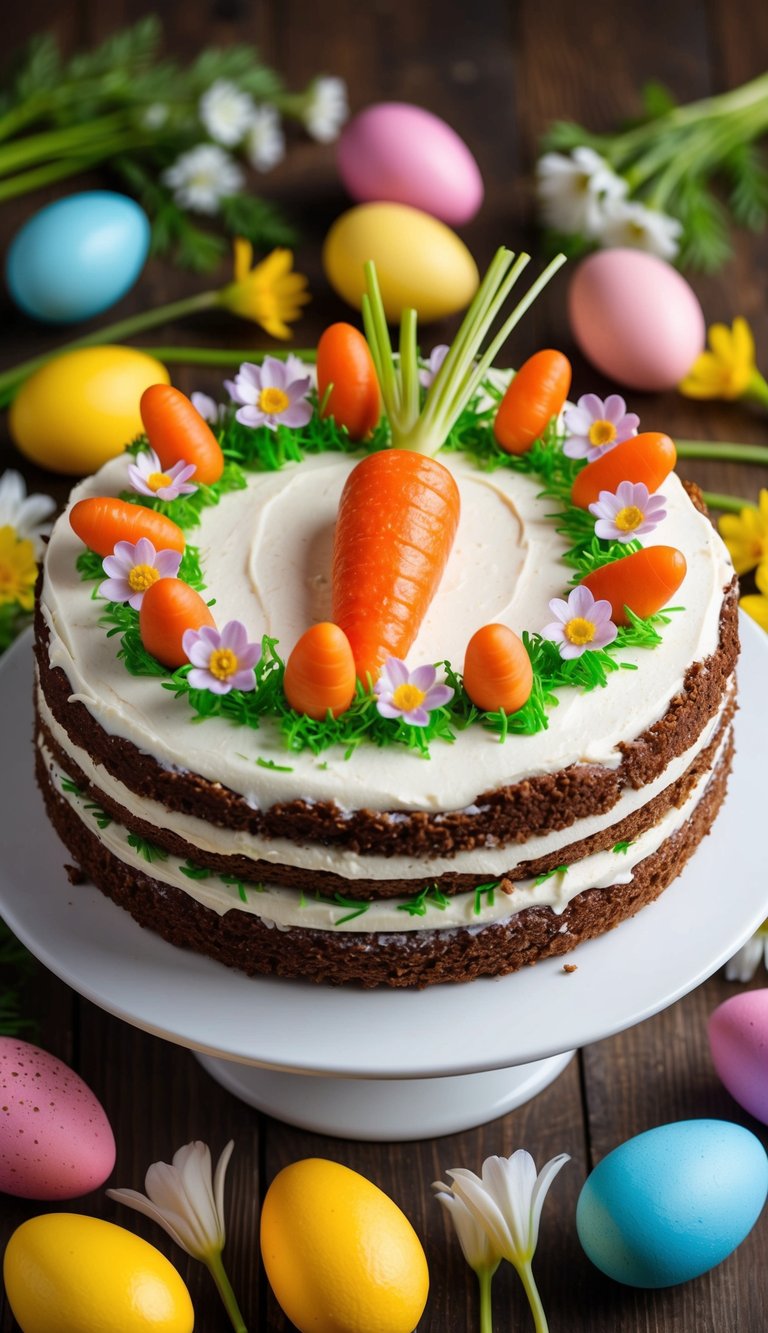
When I think of Easter, the classic carrot cake comes to mind, not just for its taste, but also for its vibrant colors and delightful aroma.
Whether you prefer a traditional recipe or a fun twist, there are many ways to create a memorable dessert. Mini carrot cakes or unique variations add a playful touch to your celebration.
In this blog post, I will share some of the best Easter carrot cake recipes. These range from classic options to creative spin-offs, making it easy to find the perfect dessert for your holiday table.
Get ready to explore these recipes and impress your guests with a delightful cake this Easter!
Ingredients
When making an Easter carrot cake, selecting the right ingredients is key. Each component plays a vital role in achieving flavor, texture, and moisture. Here’s an in-depth look at what you need.
Flour Choices
Flour is the foundation of any cake. I typically opt for all-purpose flour in my carrot cake. It provides a good balance between structure and tenderness.
Here’s a quick comparison of flour types:
| Flour Type | Texture | Best Use |
|---|---|---|
| All-Purpose Flour | Light and fluffy | Standard cakes |
| Cake Flour | Very soft and tender | Delicate cakes |
| Whole Wheat Flour | Denser and nuttier | Healthier, denser cakes |
Using cake flour can make the cake lighter, but blending it with all-purpose flour can offer the best of both worlds.
Types of Sweeteners
Sweeteners add flavor and moisture. I generally use granulated sugar, which blends easily and provides the right sweetness.
- Brown Sugar: Adds moisture and a slight caramel flavor.
- Honey or Maple Syrup: Offers a more complex sweetness and can make the cake extra moist.
Experimenting with different sweeteners can enhance the flavor profile. Just remember to adjust liquids if using liquid sweeteners.
Fresh vs Pre-Packaged Carrots
Carrots are the star ingredient. I strongly recommend using freshly grated carrots for the best taste and texture.
Fresh carrots provide:
- Flavor: They have a natural sweetness and moisture.
- Texture: Freshly grated carrots keep the cake moist without adding excess water.
Pre-packaged carrots can be convenient, but they might lack the freshness that elevates the cake’s flavor. If you choose pre-packaged, ensure they are finely grated.
Spices and Flavorings
Spices add warmth and complexity to the cake. I usually use a blend of cinnamon, nutmeg, and ginger for a classic taste.
Here’s what each spice contributes:
- Cinnamon: Sweetness and warmth.
- Nutmeg: A slight nutty flavor.
- Ginger: A subtle bite and brightness.
Adding vanilla extract enhances the overall flavor. A splash can transform a simple carrot cake into something special.
Additional Add-Ins
I enjoy customizing my carrot cake with various add-ins. Here are some popular options:
- Nuts: Chopped walnuts or pecans add crunch and flavor.
- Raisins or Cranberries: Dried fruits provide sweetness and chewiness.
- Pineapple: Crushed pineapple can increase moisture, but be careful with the amount.
Selecting the right add-ins enhances both flavor and texture, making each bite delightful.
Baking Techniques
Mastering the right baking techniques is key to a successful Easter carrot cake. Here’s what I find important to ensure your cake turns out delicious and moist.
Mixing Methods
Using proper mixing methods is crucial for the texture of the cake. I often employ the following techniques:
- Creaming Method: Start by beating together sugar and fat (like butter) until light and fluffy. This adds air and creates a tender crumb.
- Incorporation of Wet Ingredients: Gradually mix in eggs, vanilla, or any liquid ingredients. This helps blend the flavors without overworking the batter.
- Adding Dry Ingredients: Combine flour, baking powder, and spices. I fold them gently into the wet mix. This keeps the cake light and prevents it from becoming dense.
Using a spatula rather than a mixer for the last step can prevent overmixing, which keeps my cake soft.
Ideal Baking Temperatures
Baking at the right temperature is essential to achieve the best results. I always preheat my oven to 350°F (175°C), which is ideal for carrot cake.
- Temperature Control: An oven thermometer ensures consistent heat. This prevents uneven baking.
- Oven Position: I place my cake pans in the center of the oven for even heat distribution.
- Baking Time: Generally, carrot cakes take about 25 to 35 minutes to bake. It’s vital not to rush this process.
Setting a timer ensures the cake is baked perfectly. Too high a temperature can burn the edges, while too low results in underbaking.
Testing for Doneness
Knowing when my carrot cake is done is important to avoid a gooey center. I use these simple steps:
- Toothpick Test: I insert a toothpick or cake tester in the center. If it comes out clean or with a few crumbs, the cake is ready.
- Spring Back Method: Gently press the top of the cake. If it springs back, it’s done; if it leaves an indentation, it needs more time.
- Visual Cues: I look for a golden-brown color and a slight pull from the sides of the pan.
Frosting and Decoration
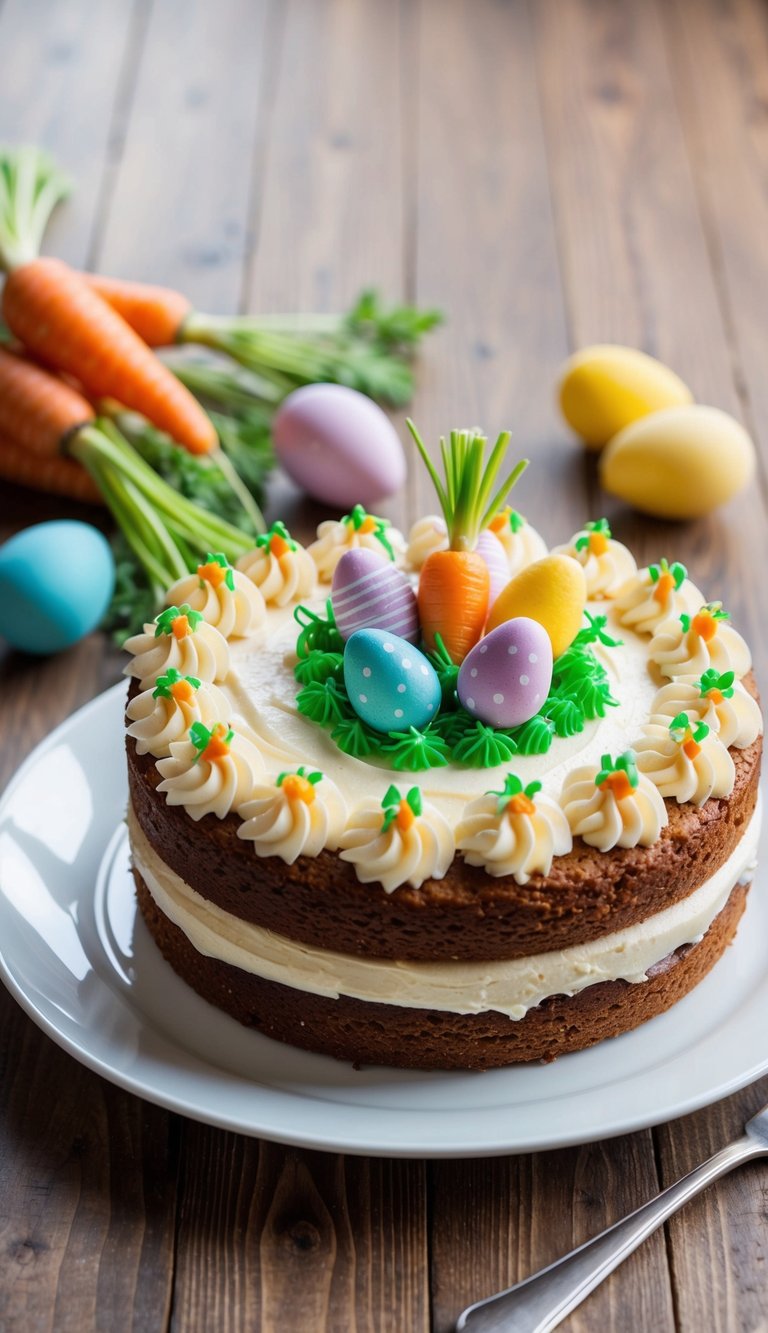
Frosting and decoration are essential parts of creating an Easter carrot cake that not only tastes great but also looks beautiful. The right frosting enhances the flavor, while attractive decorations can bring festive charm to the dessert.
Cream Cheese Frosting Varieties
Cream cheese frosting is a classic choice for carrot cake. Its tangy flavor balances the sweetness of the cake perfectly. I like to prepare several variations to suit different tastes.
- Classic Cream Cheese Frosting: This standard version is made with cream cheese, butter, powdered sugar, and vanilla. It is creamy and smooth.
- Lemon Cream Cheese Frosting: Adding lemon juice and zest gives a bright, citrus flavor that complements the spices in the cake.
- Spiced Cream Cheese Frosting: Incorporating cinnamon and nutmeg into the frosting adds warmth and ties in with the cake’s spices.
Each variety offers a unique taste experience, allowing for customization depending on personal preference.
Decorative Toppings
Decorative toppings can elevate the look of your carrot cake. Here are some toppings I find particularly appealing:
- Chopped Nuts: Adding walnuts or pecans gives a delightful crunch and earthy flavor.
- Edible Flowers: These can bring a vibrant touch to the cake and are perfect for special occasions.
- Grated Carrot: Freshly grated carrot sprinkled on top adds color and a playful nod to the cake’s main ingredient.
- Coconut Flakes: Toasted coconut gives a tropical flair and contrasting texture.
Piping and Presentation Tips
Piping frosting can be an art. I have a few tips to help achieve a professional look:
- Use a Piping Bag: A piping bag with various tips can create beautiful borders and decorations. I recommend a star tip for rosettes.
- Practice on Paper: Before piping on the cake, I practice on a piece of parchment paper to get the hang of it.
- Chill the Cake: Ensuring the cake is chilled makes it easier to frost. This also reduces the chances of the layers shifting.
For an elegant finish, I often place decorative elements like edible flowers or candied carrots on top after piping. This creates a stunning focal point on the cake.
Health and Dietary Considerations
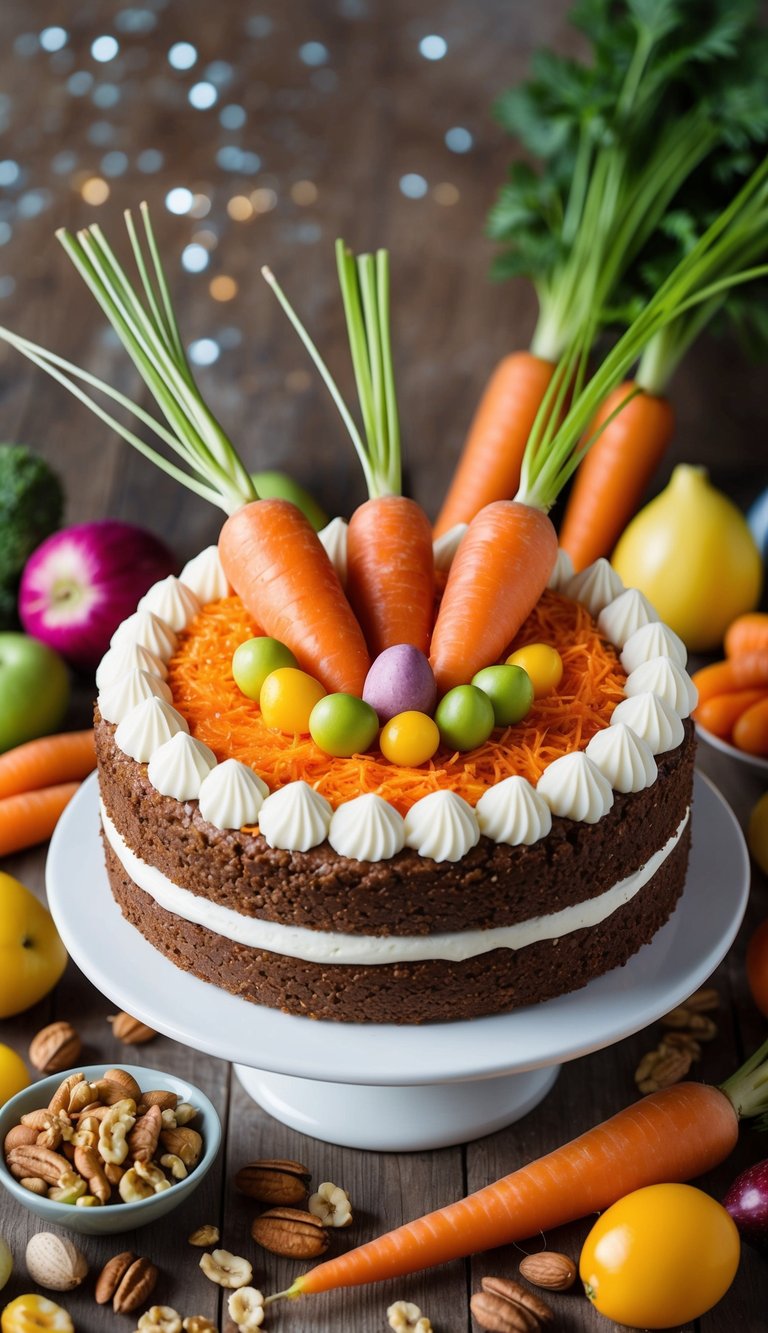
When baking an Easter carrot cake, it’s important to consider various health and dietary needs.
There are several options available that cater to gluten-free and vegan diets. I also provide relevant nutritional information to help make informed choices.
Gluten-Free Alternatives
For those avoiding gluten, several alternatives can replace traditional wheat flour in carrot cake recipes.
Common gluten-free options include:
- Almond Flour: Nutty flavor and moist texture.
- Coconut Flour: High in fiber but absorptive; use less than standard flour.
- Oat Flour: Ground oats provide a mild taste and good structure.
When using these alternatives, I often combine different flours to achieve the right consistency. For example, a mix of almond and coconut flour can create a soft crumb while maintaining moisture.
Be sure to check for certified gluten-free labels to avoid cross-contamination. This is crucial for those with gluten intolerance or celiac disease.
Vegan Variations
If I want to make a vegan version of carrot cake, there are simple swaps for traditional ingredients. Here are a few:
- Egg Replacers: Use flaxseed meal or chia seeds mixed with water. This acts as a binder and adds healthy fats.
- Dairy-Free Milk: Almond, coconut, or soy milk can substitute cow’s milk without sacrificing taste.
- Oil: Coconut oil or vegetable oil ensures the cake remains moist.
Many recipes also incorporate mashed bananas or applesauce for added sweetness and moisture. These substitutions help maintain the cake’s texture and flavor, making it enjoyable for everyone.
Nutritional Information
A slice of carrot cake can offer some nutritional benefits due to its ingredients. Here’s a breakdown:
| Nutrient | Amount per Slice |
|---|---|
| Calories | Approximately 300 |
| Carbohydrates | 40 grams |
| Fiber | 2-3 grams |
| Protein | 3-4 grams |
| Sugars | 20-25 grams |
Carrots contribute vitamins like A and K, along with fiber. While carrot cake is a treat, I find it provides more nutrition than standard cakes, thanks to the healthy ingredients. Just be mindful of portion sizes, especially with added sugars.
Storing and Serving Suggestions
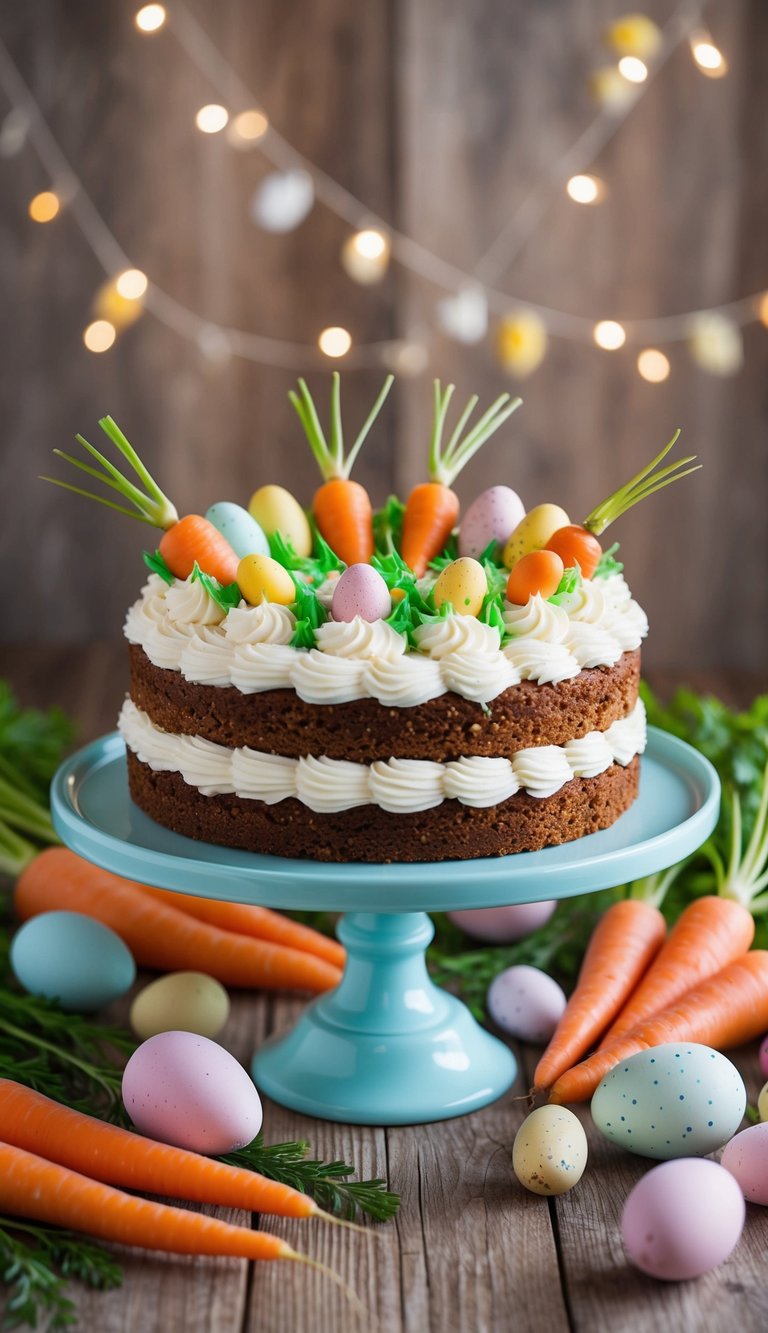
Proper storage and presentation of Easter carrot cake can enhance its flavor and keep it fresh. I’ve gathered practical methods to ensure your cake stays delicious and appealing when it’s time to serve.
Proper Storage Methods
To keep your Easter carrot cake fresh, choose the right storage method. If the cake has cream cheese frosting, it must be refrigerated. Here are some effective ways to store it:
- Refrigerator: Cover the cake with plastic wrap or a cake dome. This protects it from drying out and odors. It can last up to five or six days in the fridge.
- Freezer: For longer storage, wrap the cake tightly in plastic wrap and then in aluminum foil. This helps prevent freezer burn. When you’re ready to eat it, let it thaw at room temperature.
- Room Temperature: If you plan to serve the cake within a couple of days, it can be stored at room temperature. Just make sure it’s in a cool, dry place, covered with a cloth.
Serving Size and Presentation
Appealingly serving carrot cake enhances the dessert experience. I recommend the following tips for serving:
- Slice easily: For neat slices, use a sharp knife. Warm the knife in hot water, then dry it off before cutting to make serving easier.
- Portion Size: A standard slice of carrot cake is about 1-2 inches wide. Consider serving with a dollop of whipped cream or a scoop of vanilla ice cream for added flavor.
- Decorative Touch: Garnish each slice with chopped walnuts or a sprinkle of cinnamon. A decorative plate can also enhance the visual appeal.
Popular Easter Carrot Cake Variations
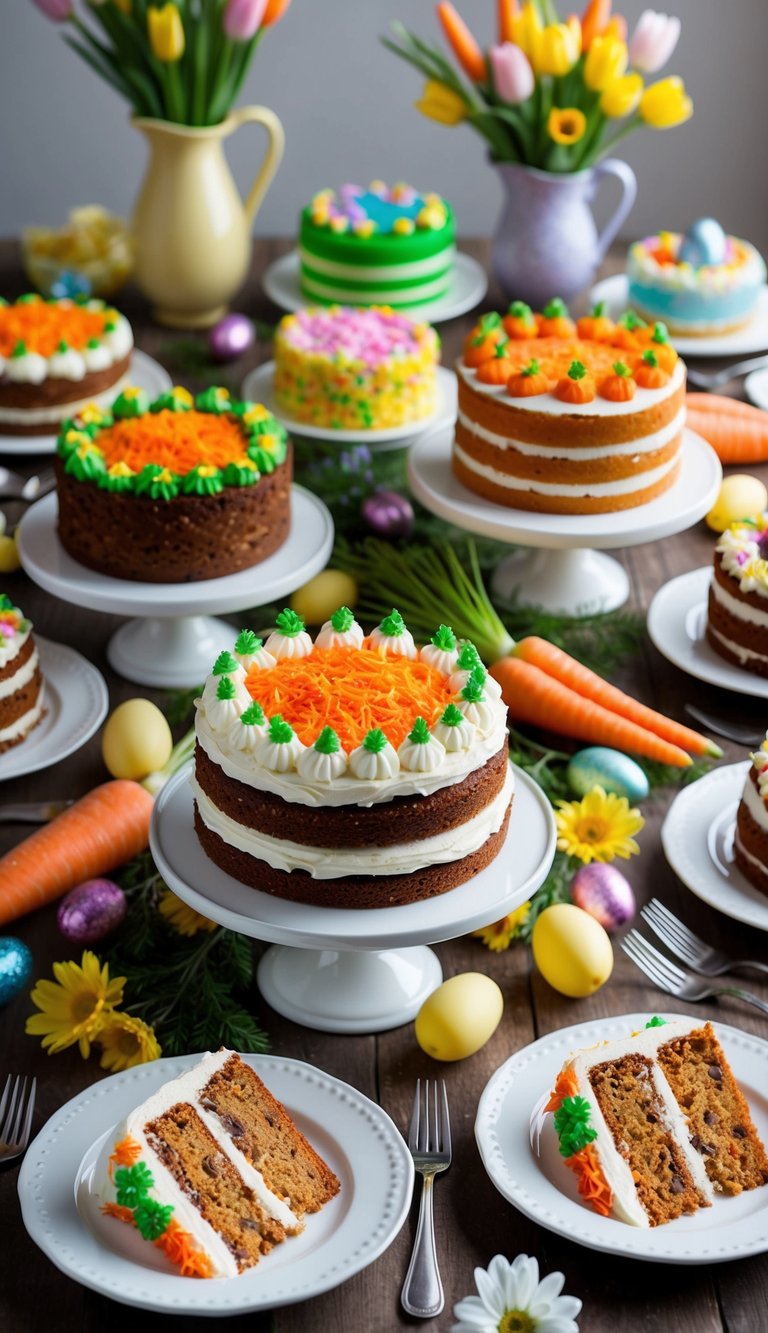
There are many exciting ways to enjoy carrot cake during Easter. Each variation offers a unique twist while keeping the classic flavors. Here, I explore three popular adaptations that add fun and creativity to this beloved dessert.
Cupcake Adaptations
Carrot cake cupcakes are a delightful choice for Easter celebrations. They are easy to serve and great for kids and adults alike. The small size makes them perfect for individual portions.
Key features of carrot cake cupcakes:
- Moist texture: These mini cakes retain the signature moistness of traditional carrot cake.
- Toppings: Cream cheese frosting is a popular choice, often topped with shredded coconut or tiny carrot decorations.
These cupcakes can also incorporate other flavors, such as pineapple or spices like cinnamon and nutmeg. I find that adding crushed walnuts or pecans enhances both texture and flavor.
Bundt Cake Versions
A bundt cake is an elegant way to present carrot cake at an Easter gathering. The unique shape creates an eye-catching design that’s perfect for a festive table setting.
Elements of a bundt cake:
- Dense and moist: The bundt version is rich and typically taller than traditional cakes.
- Glaze options: A simple glaze made from powdered sugar and vanilla pairs well, allowing the cake’s flavor to shine.
Some recipes even suggest adding a swirl of cream cheese filling or incorporating chocolate chips. This gives the bundt a surprise element that can impress guests.
Layer Cake Innovations
Layer cakes elevate carrot cake to another level, making it a centerpiece for Easter dinners.
The traditional three-layer format allows for stacking and gives room for plenty of frosting.
Features of a layer cake:
- Filling choices: Adding fruit preserves or thick cream cheese frosting between the layers creates delightful surprises with every slice.
- Decorative options: I often use toasted coconut or edible flowers for a beautiful touch.
This style also opens up creative opportunities, such as using different types of carrots or adding spices.
The layered presentation makes it a showstopper that all ages will enjoy.

Ella Foster, co-founder of FoodBears.com, is a skilled writer whose love for cooking fuels her creative work. Her passion for experimenting in the kitchen brings authentic flavor and culinary inspiration to every piece she crafts for the platform.
